Bald songbird species discovered in Laos
 Birds
Birds An interesting discovery we heard about...
A songbird with a bald head living in a rugged region in Laos has been discovered by scientists from the Wildlife Conservation Society and University of Melbourne. Dubbed the "Bare-faced Bulbul" because of the lack of feathers on its face and part of its head, it is the only example of a bald songbird in mainland Asia according to scientists. It is the first new species of bulbul – a family of about 130 species – described in Asia in over 100 years.
 Image credit, University of Melbourne/Iain WoxvolA description of the new species is published in the July issue of the Oriental Bird Club's journal Forktail. Authors include Iain Woxvold of the University of Melbourne, along with Wildlife Conservation Society researchers Will Duckworth and Rob Timmins.
Image credit, University of Melbourne/Iain WoxvolA description of the new species is published in the July issue of the Oriental Bird Club's journal Forktail. Authors include Iain Woxvold of the University of Melbourne, along with Wildlife Conservation Society researchers Will Duckworth and Rob Timmins.
The thrush-sized bird is greenish-olive with a light-colored breast, a distinctive featherless, pink face with bluish skin around the eye extending to the bill and a narrow line of hair-like feathers down the centre of the crown.
The bird seems to be primarily tree-dwelling and was found in an area of sparse forest on rugged limestone karsts – a little-visited habitat known for unusual wildlife discoveries.
"Its apparent restriction to rather inhospitable habitat helps to explain why such an extraordinary bird with conspicuous habits and a distinctive call has remained unnoticed for so long," said Iain Woxvold of the University of Melbourne.
The bird was found as part of a project funded and managed by the mining company MMG (Minerals and Metals Group) that operates the Sepon copper and gold project in the region.
Fortunately much of the bird's presumed habitat falls within legally protected areas in Laos. However, quarrying of limestone looms as a potential threat to wildlife in this area, along with habitat conversion for agriculture.
In 2002 in this same area, Rob Timmins of WCS described the kha-nyou, a newly discovered species of rodent so unusual it represented the lone surviving member of an otherwise extinct genus. Three years earlier he described a unique striped rabbit in the region also new to science.




Reader Comments